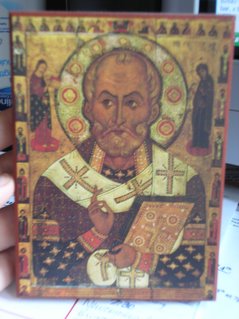St. Nicholas the Wonderworker

Nicholas was the bishop of the Christian Church in the Asia Minor city of Myra (now Demre, Turkey) in the fourth century AD. He is beloved throughout the Orthodox Christian world for his kindness and help, both during his life and afterward. He is called "Wonderworker" (or "Miraculous" or "Miracle-Worker", Greek "thavmatourgos") for the miracles which he performed and which he still performs, by God's grace.
We met a priest many years ago who had befriended our family and eventually married two of our children. He had a deep affection for religious icon paintings. This priest was patient with us when we told him bluntly we would never consider these “lovely” pieces of artwork. He concurred that to the untrained observer, many icons look somber and almost repulsive. Then he explained to us there is a holy and mysterious language to icons that must be learned before true depth of understanding takes place. From the early days of Christianity and throughout the Church's history, icons -- sacred paintings of sacred persons and holy scenes -- have been teaching aids filled with symbolism and Biblical detail often times not noticed until pointed out with Scripture attached to the reason for being there in the chosen locations as well as the style of depiction shown in the Icon itself.

St. Luke the Evangelist
Eastern Christianity records the beginning of icons as St. Luke the Evangelist painting the first images of Christ and His Mother. During the era of the Roman Empire, portraiture flourished-, images of persons were commonly painted onto flat boards. It was the age of Byzantium (300-1400 AD) that developed the fine points of sacred iconography. By the 6th century, Byzantine influence on the style of icon art was widespread.
Icon is a Greek word meaning image. It is the same word used in the Bible in Genesis 1:27 : 'God created man in His image', and again in Colossians 1:1 5 : 'Jesus is the image of the invisible God, the first born of all creation'. To Eastern Christianity, an icon is specifically a sacred image which represents biblical stories or personalities, painted in accordance with Church traditions. The Eastern Church is responsible for forming and preserving the almost 2000 year old tradition of icon painting.
During one of our monthly homeschooling group's family gatherings, our guest speaker/teacher for the event was from St. Luke’s parish, a man who homeschooled his own children, and taught at the Monastery in Mission. An Iconographer himself, he came to educate our group about Icons then proceeded to teach the teens in creating their very own mosaic detailed icon on wooden background boards. The tender care and reverence this artistic endeavor invoked with the teens was evident for all to witness, as the noise level was hushed to a quiet prayer like environment while they were creating their personal treasures.
Later with this same group, we took a trip to the Monastery in Mission to view other Icons painted by the Monks there, and sought out “Micheal O’Brien” , a personal friend to some of the members, to hear of the symbolism in the anniversary painting in the entrance to St. Luke’s Church in Pitt Meadows. He was also the editor for the magazine entitled “Nazereth” at the time, which featured icons on its monthly issued covers, and author of many successful books (Landscape of Dragons, Father Elijah and more), so he had a lot to share with us from his home in Ontario.
Several years later, we came to know another priest who had spent long periods of time in Russia working as the main chaplain for Mother Teresa of Calcutta in one of her Seminaries there. Intrigued, he had become so curious about such artwork which had spanned great lengths of historical time periods,to the point where he had located a trained Iconographer in a monastery, for the purpose of an interview and to observe the many Icons on display there. Many church icons were done in mosaics and frescoes. He found out that Icons are art and prayer combined under a set of technical rules evolved by the Eastern Church. They are usually painted on hardwood, sometimes elaborately framed, sometimes encased in precious metals and stones. In ancient times egg tempera was the primary medium--water colors mixed with egg yolk. Pigments in melted wax--encaustic painting-was also used. In current times, many icon artists use the modern acrylic paints. Gold leaf is often used as a background, representing a heavenly aura to signify the sacred character. The gold also symbolizes divine light coming through or surrounding the key figures.

An Iconographer at work
About this same time, both I and another good friend were expecting babies, within a week apart. This (friend) priest was so honored to baptize both babies on the same Sunday within one hour apart, and was indispensable in assisting us with our Russian hockey billets just prior to the birth of our babes. He spoke perfect Russian in various dialects. What a guy!
Eventually, Mother Teresa summoned him back to Russia again for a short time, and when I was expecting another baby eighteen months later, he thought of our family while living in there in Russia, and had purchased a small wooden icon for us, as a gift on the occasion of the impending birth of our new baby daughter. Though he only returned when she was eight months old, he held her and hugged her tightly, then patiently spoke of the symbolism held within this Icon so she would know it when she grew up. What a guy! A big man, our baby looked miniscule in his arms too!

From Russia with love on the birth of our eighth child.
At first we weren’t sure about Icons at all, they were ugly to us and absolutely Byzantine in nature, not a thing of beauty for sure even if we attempted to like them, and I found it difficult to see the “holy” per se at all. With this priest’s growing personal collection making appearances inside our church bit by bit over many months, he actually educated the entire congregation in the valley with their historical detail and importance to church history. Eventually we grew accustomed to them and all chuckle now over his sweet gesture and our poor manners.
Years later, another friend who is an Orthodox Christian gave us a gift of a St. Nicholas icon. It rests in a predominant area of our kitchen and will always be a loving reminder to us that this family is always holding us up in prayer as the writing on the back of it states upon presenting it to us. I completely forgot to take a photo of this for my post yesterday, the eve of St. Nicholas day. Here it is;

In this Icon, Christ and the Mother of God are depicted interceding for St. Nicholas and the scene around the outer edges relates to the Nicene Council.
Icons can be appreciated when one begins to understand their historical relevance, with much catechism found and featured in their detailed symbolism. With an understanding of what they are historically, and at the very least, like them or not, we can still offer respect to others who regard them differently , and cherish having them in their homes.
Happy St. Nicholas Day!





.jpg)













